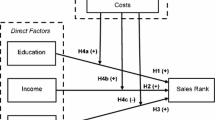Abstract
This research aims to study the differences between services sold on the Internet, based on their degree of homogeneity. While travel services are mostly sold online, other customizable services do not enjoy the same success. We carry out an empirical study based on declared intentions, risk perceptions, and actual purchasing behavior. The main findings show that: the degree of homogeneity is an adequate segmentation variable for online services; homogeneous services seem more suited to e-commerce than non-homogeneous services; a relation exists between perceived risk and intention to buy services online; and the scope of some traditional classification variables needs narrowing.


Similar content being viewed by others
References
Alba J, Lynch J, Weitz B, Janiszewski C, Lutz R, Sawyer A, Wood S (1997) Interactive home shopping: consumer, retailer, and manufacturer incentives to participate in electronic marketplaces. J Market 61(39):38–53
Beldona S, Morrison AM, O’Leary J (2005) Online shopping motivations and pleasure travel products: a correspondence analysis. Tour Manag 26(4):561–570
Bhatnagar A, Ghose S (2004) A latent class segmentation analysis of e-shoppers. J Bus Res 57(7):758–767
Çelik HE, Yilmaz V (2011) Extending the technology acceptance model for adoption of e-shopping by consumers in Turkey. J Electron Commer Res 12(2):152–164
Chen IC, Hu SC (2012) Gender differences in shoppers’ behavioural reactions to ultra-low price tags at online merchants. Electron Commer Res 12(4):485–504
Childers TL, Carr CL, Peck J, Carson S (2001) Hedonic and utilitarian motivations for online retail shopping behavior. J Retail 77(4):511–535
Cho SE, Park K (2002) Empirical taxonomy of services and service products in electronic commerce. Electron Commer Res Appl 1(3–4):339–350
Choudhury V, Karahanna E (2008) The relative advantage of electronic channels: a multidimensional view. MIS Q 32(1):179–200
CMT (2013) Informe sobre el comercio electrónico en España a través de las entidades de pago. Primer trimestre 2013. CMT, Barcelona, pp 1–13
De Figueiredo JM (2000) Finding sustainable profitability in electronic commerce. MIT Sloan Manag Rev 41(4):41–52
Fishbein M, Ajzen I (1975) Belief, attitude, intention, and behavior: an introduction to theory and research. Addison-Wesley, Reading
Girard T, Dion P (2010) Validating the search, experience, and credence product classification framework. J Bus Res 63(9–10):1079–1087
Girard T, Silverblatt R, Korgaonkar P (2002) Influence of product class on preference for shopping on the Internet. J Comput-Mediat Commun 8(1):1–22
Girard T, Korgaonkar P, Silverblatt R (2003) Relationship of type of product, shopping orientations, and demographics with preference for shopping on the Internet. J Bus Psychol 18(1):101–120
Kauffman RJ, Walden EA (2001) Economics and electronic commerce: survey and directions for research. Int J Electron Commer 5(4):5–116
Keisidou E, Sarigiannidis L, Maditinos D (2011) Consumer characteristics and their effect on accepting online shopping, in the context of different product types. Int J Bus Sci Appl Manag 6(2):31–51
Kiang MY, Ye Q, Hao Y, Chen M, Li Y (2011) A service-oriented analysis of online product classification methods. Decis Support Syst 52(1):28–39
Kim LH, Kim DJ, Leong JK (2005) The effect of perceived risk on purchase intention in purchasing airline tickets online. J Hosp Leis Market 13(2):33–53
Klein LR (1998) Evaluating the potential of interactive media through a new lens: search versus experience goods. J Bus Res 41(3):195–203
Korgaonkar P, Silverblatt R, Girard T (2006) Online retailing, product classifications, and consumer preferences. Internet Res 16(3):267–288
Lee SM, Chen L (2011) An integrative research framework for the online social network service. Serv Bus 5(3):259–276
Lee CC, Cheng HK, Cheng HH (2007) An empirical study of mobile commerce in insurance industry: task–technology fit and individual differences. Decis Support Syst 43(1):95–110
Levin AM, Levin IP, Weller JA (2005) A multi-attribute analysis of preferences for online and offline shopping: differences across products, consumers, and shopping stages. J Electron Commer Res 6(4):281–290
Li H, Suomi R (2007) Customer’s perceptions and intentions on online travel service delivery: an empirical study in China. In: Wang W (ed) Integration and innovation orient to e-society, vol 2. Springer, Wuhan, pp 113–122
Liu X, Wei K (2003) An empirical study of product differences in consumers’ e-commerce adoption behavior. Electron Commer Res Appl 2(3):229–239
Lovelock C, Gummesson E (2004) Whither services marketing? In search of a new paradigm and fresh perspectives. J Serv Res 7(1):20–41
Mamaghani F (2009) Impact of e-commerce on travel and tourism: an historical analysis. Int J Manag 26(3):365–375
Onkvisit S, Shaw JJ (1991) Marketing theories, models and general issues: is services marketing “really” different? J Prof Serv Market 7(2):3–17
ONTSI (2013) Estudio sobre Comercio Electrónico B2C 2012. Edición 2013. ONTSI, Madrid, pp 1–77
Overby JW, Lee EJ (2006) The effects of utilitarian and hedonic online shopping value on consumer preference and intentions. J Bus Res 59(10–11):1160–1166
Peterson RA, Balasubramanian S, Bronnenberg BJ (1997) Exploring the implications of the internet for consumer marketing. J Acad Mark Sci 25(4):329–346
Rosen KT, Howard AL (2000) E-retail: gold rush or fool’s gold? Calif Manag Rev 42(3):72–100
Shim S, Eastlick MA, Lotz SL, Warrington P (2001) An online prepurchase intentions model: the role of intention to search. J Retail 77(3):397–416
The Economist (2001) Spain. Country Commerce Report. The Economist Intelligence Unit, London, pp 1–4
To PL, Liao C, Lin TH (2007) Shopping motivations on Internet: a study based on utilitarian and hedonic value. Technovation 27(12):774–787
Vargo SL, Lusch RF (2004) The four service marketing myths: remnants of a goods-based, manufacturing model. J Serv Res 6(4):324–335
Verhagen T, Boter J, Adelaar T (2010) The effect of product type on consumer preferences for website content elements: an empirical study. J Comput-Mediat Commun 16(1):139–170
Wungwanitchakorn A (2002) Adoption intention of banks’ customers on internet banking service. ABAC J 22(3):63–80
Zeithaml VA, Parasuraman A, Berry LL (1985) Problems and strategies in services marketing. J Market 49(2):33–46
Zhao AL, Hanmer-Lloyd S, Ward P, Goode MMH (2008) Perceived risk and Chinese consumers’ internet banking services adoption. Int J Bank Market 26(7):505–525
Author information
Authors and Affiliations
Corresponding author
Rights and permissions
About this article
Cite this article
Agudo-Peregrina, Á.F., Pascual-Miguel, F.J. & Chaparro-Peláez, J. It’s never the same: the role of homogeneity in online services. Serv Bus 8, 453–464 (2014). https://doi.org/10.1007/s11628-014-0249-7
Published:
Issue Date:
DOI: https://doi.org/10.1007/s11628-014-0249-7




